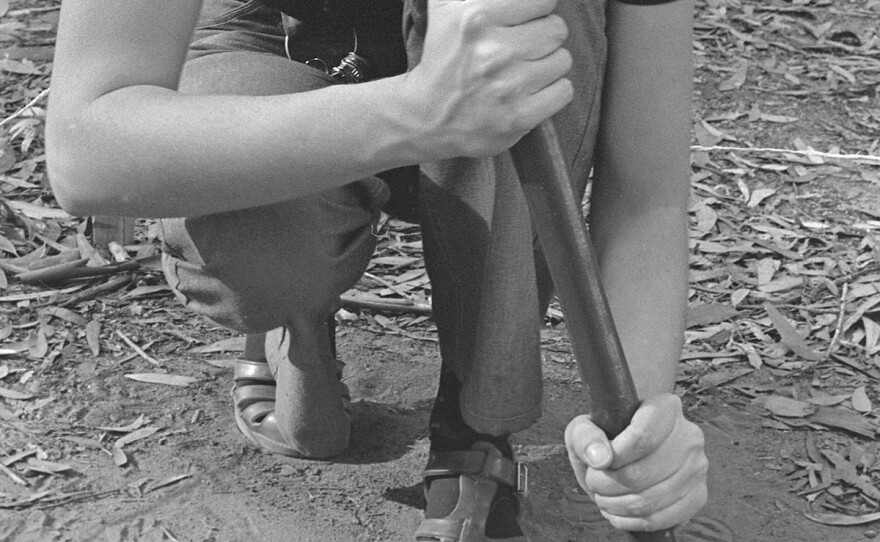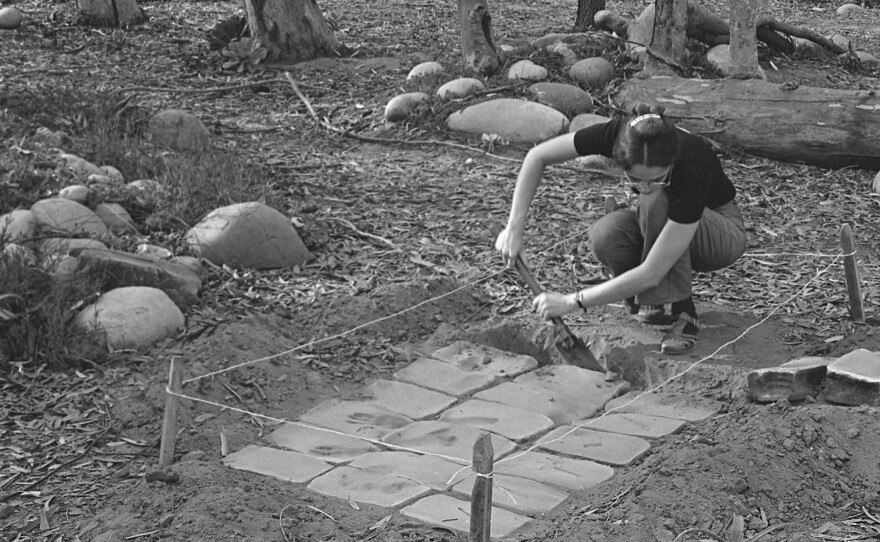Regular visitors to the UCSD campus have by now grown accustomed to the bizarre sight of a small house protruding from the School of Engineering building, high above the Warren College Mall.

Inspired by a Rhode Island cottage, Korean-born artist Do-Ho Suh's spectacular "Fallen Star" is perched like a cap at a jaunty, if slightly sickening angle on the corner of a seventh-story rooftop. The latest jewel in the crown of the Stuart Collection, "Fallen Star" is the 18th addition to the campus wide assortment of site-specific works commissioned from leading artists. It's a big event when ambitious new pieces are added and informative brochures make it easy for people to stroll the campus and admire these prominent works of art.
A Mysterious Artwork


Art lovers who meander along Alexis Smith's "Snake Path" and take in the view of "Fallen Star" are unknowingly walking right past an unmarked, mysterious art installation that's been part of the campus for decades. Those that stick to the path will never see this hidden artwork or learn of the tragedy it commemorates. Set into the earth like an ancient relic, the object predates the Stuart Collection.
There has been no fanfare for Virginia Maksymowicz's "Thirty Blocks," though the work has been in place since 1976 and has earned a place in campus folklore.
"Thirty Blocks" consists of three rows of fired clay slabs (or blocks, or "bricks") set in the ground just east of the Geisel Library, in what some people call the George Winne Memorial Grove. The ceramic sculpture was part of UCSD grad student Virginia Maksymowicz's MFA project.
While the clay was still damp, the artist lay down on her side leaving an impression of her body in the slabs. Objects from her purse were similarly pressed into the clay, which was then fired in a kiln, creating a pseudo archaeological record of her own life. The surface appears scorched and blackened in places.
Like the works in the Stuart Collection, the artist's placement of "Thirty Blocks" is critical. It was a deliberate response to an act of anti-war protest that shocked the campus during the Vietnam war.
The Protest

May 10th, 1970 was another sunny day in La Jolla; a Sunday afternoon during an unprecedented period of unrest on the relatively new UCSD campus. That's when twenty-three-year old George Winne Jr. doused himself with gasoline and lit himself on fire in the middle of Revelle College Plaza.
Students nearby got Winne to the ground and struggled to put out the fire, but several were burned in the process. Witnesses said Winne had a cardboard sign with this message: In God's Name End The War.
Winne eventually died after being taken to Scripps Hospital.
Winne was a history student who would have graduated that June. He was apparently inspired by the example of other anti-war self-immolators. Winne's act of absolute opposition came just days after the infamous Kent State killings, during the largest wave of protests in the history of American higher education. In California, where there had already been three instances of self-immolation in opposition to the war, Governor Ronald Reagan shut down the State's colleges and universities for a week.


Students placed candles and spring flowers in a circle on the charred ground of Revelle Plaza. Posters were printed showing the makeshift memorial accompanied by Winne's poignant message. The art department circulated handbills calling for a George Winne Memorial Shrine, but for decades no official marker existed to commemorate the tragedy.
As student Niall Twohig and professor Jorge Mariscal wrote in a 2012 letter to The Guardian on the 42nd anniversary of Winne's death: "No plaque or memorial marks the site at Revelle Plaza where Winne took his life...the Winne memorial is not marked on official campus maps. In a similar sense, Winne’s story is not marked in the official history of UCSD."
The writers describe an unofficial commemorative site located "...across campus (from Revelle), tucked away in the woods next to the "Snake Path" and in the western shadow of 'Fallen Star'." They're referring to the hollow on the north side of the "Snake Path" where "Thirty Blocks" is resting peacefully next to a fallen tree. There's another artwork there, actually, a steel sculpture by former art faculty member Michael Todd that people have surrounded with funky chairs and are using as a table.
A Contemporary Legend
Over the years, this stand of Eucalyptus just southeast of the Geisel Library became George Winne's de facto memorial. In 2000, a small bronze plaque was finally put in place to make it official. The artworks installed there were cited in the commemorative installations application submitted by local writer and musician David Klowden, who was then a graduate student in the Warren College Writing Program. Klowden and other students raised money to pay for the plaque so that Winne would not be forgotten.
Each year on May 10th, a handful of people still pause to remember the activist in this shady spot some distance from Revelle Plaza.



But after thirty years without any proper institutional memorial (after all, the horrific suicide was not something the University wanted to remind people of), the story became mythic and confused. It took on a life of its own.
Anonymously installed in the Memorial Grove, Virginia Maksymowicz's 1976 sculpture became part of that mystery.
As a UCSD student, the artist says she heard about George Winne and saw a connection between her sculpture and Winne's fiery death.
In her thesis Maksymowicz describes thinking about mortality and our inevitable return to the earth and working with "death imagery." She chose low-tech materials, earth and clay, and began leaving partially obscured, fragmented body casts in woodsy areas around campus.
As her work progressed, she started making impressions in clay made from ordinary household objects and her own body to leave behind a kind of fake fossil record. This was part of the notion behind "Thirty Blocks." The impressions did not reveal any specific identity. She hoped they would serve as puzzles for future generations to ponder.
By carefully selecting a pre-existing memorial site, Maksymowicz capitalized on the quiet solemnity of the location. She hoped to lure the viewer into a meditation on death and an awareness of the traces we leave behind.
On Facebook Maksymowicz said she is "...amazed at how long the sculpture has survived. I never got permission to install it; I just went out one day with a shovel and dug a hole."
A rumor circulated that bricks had been removed from the very spot where Winne had burned himself in Revelle Plaza and installed in the Grove. This added to the confusion surrounding Winne's death and Maksymowicz's ambiguous art work.
Ultimately, the myths around "Thirty Blocks" surfaced online and forced Maksymowicz to show her hand. After seeing a photo of her work erroneously identified as bricks from Revelle College on a Wikipedia page about Winne, the artist came forward to set the record straight.
Maksymowicz, an NEA Fellowship recipient who has exhibited widely and teaches at Franklin and Marshall College in Pennsylvania, edited the Wikipedia entry and explained via Facebook that she chose to locate "Thirty Blocks" in the Grove, "...because I thought there would be a resonance between Winne's self-immolation and the imagery in my sculpture. I didn't want to sign the sculpture because I thought anonymity would add to mystery of the piece. Thirty-five years later, I have found out that it worked!"





